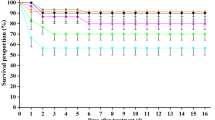Abstract
Lethal concentration (LC) has been widely used to estimate pesticide toxicity. However, it does not consider the sub-lethal effects. Therefore we included the instantaneous rate of increase in association with LC to estimate population-level effects of the acaricides fenbutatin oxide and sulfur on the predator Iphiseiodes zuluagai and its prey, the phytophagous southern red mite, Oligonychus ilicis. The predator was 32.84x and 17.20x more tolerant to fenbutatin oxide and sulfur, respectively, than its prey, based on LC50 estimates obtained from acute concentration–mortality bioassays. The instantaneous rate of population growth in both mite species decreased with increasing acaricide concentration. Both acaricides provided effective control of O. ilicis at their recommended concentrations, but sulfur drastically compromised the predator populations quickly leading them to extinction due to the low reproductive potential of this species compared with its prey.
Similar content being viewed by others
References
W.S. Abbott (1925) ArticleTitleA method of computing effectiveness of an insecticide J. Econ. Entomol. 18 265–267
E. Andrei (1999) Compêndio de Defensivos Agrícolas, 6th ed Editora Andrei São PauloBrazil
E.J. Calabrese (1999) ArticleTitleEvidence that hormesis represents an “overcompensation” response to a disruption in homeostasis Ecotoxicol. Environ. Safety 42 135–137 Occurrence Handle10.1006/eesa.1998.1729 Occurrence Handle10051361
E.J. Calabrese L.A. Baldwin (2003) ArticleTitleHormesis: the dose–response revolution Annu. Rev. Pharmacol. Toxicol. 43 175–197 Occurrence Handle10.1146/annurev.pharmtox.43.100901.140223 Occurrence Handle12195028
P. Calow R.M. Sibly (1990) ArticleTitleA physiological basis of population processes: ecotoxicological implications Funct. Ecol. 4 283–288
J.R. Carey (1993) Applied Demography for Biologists with Special Emphasis on Insects Oxford University Oxford
J.P. Dempster (1968) ArticleTitleThe sublethal effect of DDT on the rate of feeding by ground beetle Harpalus rufipes Entomol. Exp. Appl. 11 51–54 Occurrence Handle10.1007/BF00295305
V.E. Forbes (2000) ArticleTitleIs hormesis an evolutionary expectation? Funct. Ecol. 14 12–24 Occurrence Handle10.1046/j.1365-2435.2000.00392.x
V.E. Forbes P. Calow (1999) ArticleTitleIs the per capita rate of increase a good measure of population-level effect in ecotoxicology? Environ. Toxicol. Chem. 18 1544–1556 Occurrence Handle10.1897/1551-5028(1999)018<1544:ITPCRO>2.3.CO;2
D.J. Hall (1964) ArticleTitleAn experimental approach to the dynamics of a natural population of Daphnia galeata mendotae Ecology 45 94–112
S.A. Hassan F. Bigler H. Bogenshutz E. Boller J. Brun J.N.M. Calis J. Coremans-Pelseneer C. Duso A. Grove U. Heimbach N. Helver H. Hokkanen G.B. Lewis F. Mansur L. Moreth L. Polgar L. Samsoe-Petersen B. Sauphanor A. Staubli G. Sterk A. Vainio M. van de Veire G. Viggiani H. Vogt (1994) ArticleTitleResults of the sixth Join Pesticide Testing Programme of the IOBC/WPRS – working group “Pesticides and Beneficial Organisms” Entomophaga 39 107–119
W.P.J. Overmeer A.Q. van Zon (1981) ArticleTitleA comparative study of the effect of some pesticides on three predaceous mite species: Typhlodromus pyri Amblyseius potentillae A. bibens (Acarina: Phytoseiidae) Entomophaga 26 3–9
C. Potter (1952) ArticleTitleAn improved laboratory apparatus for applying direct sprays and surface films, with data on the electrostatic charge on atomized spray films Ann. Appl. Biol. 39 1–29
P.R. Reis E.B. Alves (1997) ArticleTitleCriação do ácaro predador Iphiseiodes zuluagai Denmark and Muma (Acari: Phytoseiidae) em laboratório Anais da Sociedade Entomológica do Brasil 26 565–568
P.R. Reis E.B. Alves E.O. Sousa (1997) ArticleTitleBiologia do ácaro-vermelho do cafeeiro Oligonychus ilicis (McGregor1917) Ciência e Agrotécnica 21 260–266
P.R. Reis L.G. Chiavegato E.B. Alves (1998a) ArticleTitleBiologia de Iphiseiodes zuluagai Denmark and Muma (Acari: Phytoseiidae) Anais da Sociedade Entomológica do Brasil 27 185–191
P.R. Reis L.G. Chiavegato G.J. Moraes E.B. Alves E.O. Sousa (1998b) ArticleTitleSeletividade de agroquímicos ao ácaro predador Iphiseiodes zuluagai Denmark & Muma (Acari: Phytoseiidae) Anais da Sociedade Entomológica do Brasil 27 265–274
P.R. Reis E.O. Souza (2001) ArticleTitleSeletividade de chlorfenapyr e fenbutatin-oxide sobre duas espécies de ácaros predadores (Acari: Phytoseiidae) em citros Revista Brasileira de Fruticultura 23 584–588
J.L. Robertson H.K. Preisler (1992) Pesticide Bioassays with Arthropods CRC Boca Raton, FL, USA
SAS Institute. 1997. SAS/STAT User’s Guide: Statistics, version 6.12. SAS InstituteCary, NC, USA.
R.M. Sibly P. Calow (1986) Physiological Ecology of Animals – An Evolutionary Approach Blackwell Oxford
J.D. Stark J.A.O. Banken (1999) ArticleTitleImportance of population structure at the time of toxicant exposure Ecotoxicol. Environ. Safety 42 282–287 Occurrence Handle10.1006/eesa.1998.1760 Occurrence Handle10090817
J.D. Stark J.E. Banks (2003) ArticleTitlePopulation-level effects of pesticides and other toxicants on arthropods Annu. Rev. Entomol. 48 505–519 Occurrence Handle10.1146/annurev.ento.48.091801.112621 Occurrence Handle12221038
J.D. Stark T. Rangus (1994) ArticleTitleLethal and sublethal effects of the neem insecticideMargosan-O, on pea aphid Pestic. Sci. 41 155–160
J.D. Stark L. Tanigoshi M. Bounfour A. Antonelli (1997) ArticleTitleReproductive potential: its influence on the susceptibility of a species to pesticides Ecotoxicol. Environ. Safety 37 273–279 Occurrence Handle10.1006/eesa.1997.1552 Occurrence Handle9378095
W.K. Walthall J.D. Stark (1997a) ArticleTitleComparison of acute mortality and population growth rate as endpoints of toxicological effect Ecotoxicol. Environ. Safety 37 45–52 Occurrence Handle10.1006/eesa.1997.1521
W.K. Walthall J.D. Stark (1997b) ArticleTitleComparison of two population level ecotoxicological endpoints: the intrinsic (r m) and instantaneous (r i) rates of increase Environ. Toxicol. Chem. 16 1068–1073 Occurrence Handle10.1897/1551-5028(1997)016<1068:COTPLE>2.3.CO;2
T.V. Zanuncio J.E. Serrão J.C. Zanuncio R.N.C. Guedes (2003) ArticleTitlePermethrin-induced hormesis on the predator Supputius cioncticeps (Stål, 1860) (Heteroptera: Pentatomidae) Crop Prot. 22 941–947 Occurrence Handle10.1016/S0261-2194(03)00094-2
Author information
Authors and Affiliations
Corresponding author
Rights and permissions
About this article
Cite this article
Teodoro, A., Fadini, M., Lemos, W. et al. Lethal and sub-lethal selectivity of fenbutatin oxide and sulfur to the predator Iphiseiodes zuluagai (Acari: Phytoseiidae) and its prey, Oligonychus ilicis (Acari: Tetranychidae), in Brazilian coffee plantations. Exp Appl Acarol 36, 61–70 (2005). https://doi.org/10.1007/s10493-005-0507-4
Received:
Accepted:
Issue Date:
DOI: https://doi.org/10.1007/s10493-005-0507-4




